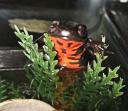Hi,
Ever wonder where wild fire-bellied toads live?
There are two different genera of toads referred to as fire-bellied toads. We are in the genera of Bombina. There are others in the genera of Bombina but we are the ones that are also sometimes called Oriental fire-bellied toads. In the wild we live at 5,300 to 10,000 feet above sea level in parts of Northeastern China, Southeastern Siberia, Korea and the Tsushima and Kyushu islands of Japan.
 China
China  Russia
Russia  South Korea
South Korea  Japan
Japan
In our natural habitat we are able to withstand a low temperature of 41F (5C), and a high temperature of 86F (30C). Toad owners need to keep in mind that in the wild we have our natural habitat to help us survive these temperatures. Since you cannot provide us with our true natural habitat we need a more even temperature of 64.4-68F (18-20C). We may need extra heat in the winter months, or we could hibernate (if you provide the right environment for hibernation) at 41-59F (5-15C) for a few months.
 We usually are found hanging out floating or swimming in ponds and streams near the shore in the wild.
We usually are found hanging out floating or swimming in ponds and streams near the shore in the wild.
 We are very special because, unlike most toads, our tongues do not fold out to catch crickets (YUMMMMM!). Instead we have to stalk our prey, jump right up to it and grab it with our mouth. (See “The Best Cricket Hunt Yet”) Then, if the prey is too large to be just one bite we use our front legs to shove it into our mouth.
We are very special because, unlike most toads, our tongues do not fold out to catch crickets (YUMMMMM!). Instead we have to stalk our prey, jump right up to it and grab it with our mouth. (See “The Best Cricket Hunt Yet”) Then, if the prey is too large to be just one bite we use our front legs to shove it into our mouth.
 When we are in the wild and a predator comes along we often arch our back, raise our front and back legs so they can see our bright “fire” belly. Sometimes we roll over on our back so all of our belly shows. That way they know if they eat us they are going to get sick from our toxin. But, in captivity we don’t usually do this since we are pretty much safe from any predators.
When we are in the wild and a predator comes along we often arch our back, raise our front and back legs so they can see our bright “fire” belly. Sometimes we roll over on our back so all of our belly shows. That way they know if they eat us they are going to get sick from our toxin. But, in captivity we don’t usually do this since we are pretty much safe from any predators.
 We love to cuddle and we even hug
We love to cuddle and we even hug  (if one of us is a male and one is a female).
(if one of us is a male and one is a female).
We all have fire-bellies on bottom but can be very different colors on our top sides. We come in many tones of brown and green ranging all the way from dark, dark brown to lime green. In fact, we sometimes change our colors and a lime green toad can become dark green. We don’t know why this happens but it may be temperature changes or even mood changes. A naturally brown toad can’t change its color to bright green, but a bright green toad will become dark green on occasion. We all have glossy black spots on our backs and two areas where we secrete our toxins. These two areas usually are a slightly different color than the rest of our body.
When we are in the wild and between 2 and 4 years old we will mate in the months of April and May. A male hugs a female just like you see in the picture above when they mate. The female then lays anywhere from 80 to 300 eggs! The eggs can be found hanging off plant stems. Tadpoles eat mainly algae and plants. The toadlets live in pools or puddles where they eat insects like flies and beetles but also worms and water spiders. They turn into toads in just a few weeks. Their metamorphosis is complete some time in July or August. Some eggs are laid in August and these will metamorphose in the spring.
We didn’t come from the wild but from a toad farm. In order to protect the ecosystem of any habitat please never take animals out of the wild to keep as pets. Just as we mentioned in an earlier blog that you should NEVER, NEVER, NEVER release your pets into the wild. We could destroy the ecosystem of your backyard if you released us out there. If you find you can’t care for your pets any longer take them to a pet store and ask the manager to find a good home for them. Most pet stores are more than willing to help you find a home for your pets.
Kind Regards,
Greenie, Brownie and Limey
 Limey, Brownie and Greenie
Limey, Brownie and Greenie
Filed under: Fire-Bellied Toads | Tagged: barking, bombina, calling, china, crickets, ecosystem, Fire-Bellied Toads, genera, habitat, hibernate, korea, mating, metamorphosis, mountain lakes, natural habitat, oriental fire-bellied toads, ponds, russia, siberia, streams, tadpoles, toadlets, toxin, wild. japan | 7 Comments »



